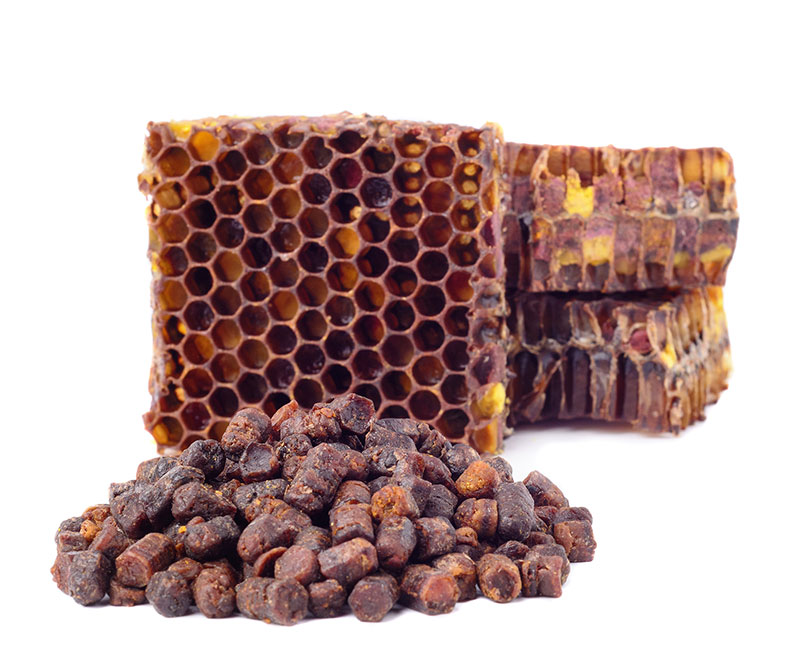
What is propolis?
The propolis used in Propol-Mel products is raw and it is only slightly processed to be part of the different formulations. We use a high-quality propolis that holds an organic certification and that comes from bee-friendly beekeepers.
Propolis is a natural resinous substance, with a complex composition and a slimy consistency that bees produce from resinous particles from different plants and that is used by bees to build, repair and protect their hive. It has been widely used from Ancient Times with different purposes and nowadays the actions, effects and possible uses of propolis in biology and medicine are being studied, highlighting its use as a food supplement as well as a natural cosmetic and within the pharmaceutical industry.

What does Propolis contain?
Over 180 compounds have been isolated from propolis. Its resins and balms must be noted, which contain flavonoids and phenolic acids, or its esters (50%). Its content in waxes is very variable (7.5 – 35%), which will affect the corresponding remaining compounds: volatile oils (10%); pollen (5%) and impurities (4.4 – 19.5%).
It also contains small amounts of terpenes, tannins, traces of secretions from the salivary glands of bees and, depending on its origin, potential contaminants. Its active compounds are bioflavonoids, which include flavanons, flavonols, flavanones and flavanonols. The majority of the studies conducted are focused on determining its flavonoid content and on their possible medical use.
Depending on the geographical location of the hive and on the production method used by the beekeeper, the composition of propolis can be very variable. Usually, propolis is evaluated through a chemical test that determines the total amount of phenols. However, it is known that isolated phenols cannot be compared to the synergic action of all propolis nutrients as a whole. Thus, its origin will clearly define its quality.
On one hand, we have the Mediterranean propolis from hives that produce multi-flower honey, which are the ones with a greater balance. On the other hand, we find Italian, Swiss and East European propolis, which are basically made from pine tree (Pinus nigra) secretions. There are also propolis from Chile, Brazil and China, produced with bees that grow in other types of vegetation. An average hive can produce between 80 and 400 grams of propolis per year.
A minimum quality control of propolis demands:

To be free of any toxic contaminant.

To contain a low percentage of wax, insoluble matter and ashes.

To define its botanic origin to determine the type of active compounds.

To contain high levels of active substances.
Benefits
As an antioxidant, it protects from oxidized oils and serum lipoproteins through the activity of anti-free radicals and the inhibitory effects on cuprous oxide.
Anti-bacterial and anti-fungal: effective against many species of microorganisms and fungi due to its high content in flavonoid aglycons and phenolic compounds.
Anti-viral: due to its content in phenols like caffeic and ferulic esters.
Propolis is immunostimulating when taken orally.
Anti-inflammatory and analgesic: also due to the action of certain phenols such as caffeic acid phenethyl ester or kaempferida.
Anti-toxic able of inhibiting the chemo toxicity action thanks to galangin, another flavonoid.
It remineralizes tooth enamel and is anti-caries.
Contraindications
Propolis is relatively non-toxic, daily doses of 1400 mg/kg have no negative side-effects in mice, although chewing large amounts of raw propolis can produce nausea and digestive upset.
It shall be also taken into account that there is always a small percentage of people who are allergic to some of its components, so a preliminary test should be performed prior consumption or external application.
Propolis processing
The organic propolis in Propol-Mel products comes from beekeepers that are bee-friendly. It undergoes the strict minimum processing so that the original product may remain intact to the extent possible. The propolis we use in all our products is certified organic.
Firstly, we need quality propolis. This is extremely important. A quality raw material and a proper processing will allow obtaining quality products. Although over 180 bioactive compounds have been isolated from propolis, when propolis by-products are analysed, only their total amount of polyphenols can be assessed. An extensive comparative analysis of two different propolis would be quite expensive. Therefore, unfortunately, it is very hard to assess the quality of an already processed propolis.
For instance, a large amount of low quality propolis can be used to obtain a tincture that can be globally compared to another tincture that has been produced with a smaller amount of propolis but of a higher quality. It will certainly reveal a total amount of polyphenols equal or greater. However, it is very likely that, in terms of its variety of bioactive compounds, it will be poorer than the one made of high quality propolis.
First propolis processing
Although propolis can be used for cosmetics, it must be processed with maximum hygiene, since its use is largely extended for food. Thus beekeepers must process it correctly, from its collection with meshes that are placed over the hives.
Our beekeepers provide us with propolis stored in food bags with hermetic zip. Although propolis is originally in the form of flakes, it gently clumps together, adapts to the place that contains it and forms a uniform mass. Then, it is time to dice it to get pieces that are easier to handle.
Once our propolis is diced, we can move to the next processing stage.
Tincture production
It is very simple to produce our propolis tincture. We just need propolis and quality grape alcohol. Then we place them together for a specific time and shake it daily to enable the exchange of compounds from propolis to alcohol. Propolis pieces are introduced in a food-grade plastic or stainless steel container and it starts losing its integrity. Later, it is filtered to obtain a clean tincture.
This tincture can be directly bottled to obtain our propolis tincture or it can be used as an ingredient for other products. Our mouth sprays, syrups, regenerative creams, shower gels, shampoos, soap bars and toothpastes are made with propolis tinctured thus produced.
As experts in manufacturing propolis products, we offer our customers the best possible solutions. Both for those clients who want to acquire a specific product and for the ones who are looking for a private label solution with which being able to position their brand or product in the market.
Users of propolis products should know:
Hydro-alcoholic extraction is usually the first propolis by-product. This extraction, known as tincture, contains all the propolis properties. Also, it is the single stage when we can know the real percentage of pure propolis that was used to produce it. The active substances of propolis can be also extracted by simply using water or glycerol. However, the extraction contains much lesser amounts of extracted active substances, as well as just a small amount of propolis nutrients, which can be dissolved in a watery /glycerol medium in the absence of alcohol.
It occurs that many manufacturers condense propolis tinctures to obtain a product named fluid extract. These extracts have undergone a strong, physical, alcohol evaporation process to concentrate the original tincture, which damages a great amount of the nutrients in propolis. With those fluid extracts, they manufacture their products.
There are many propolis products in the market that are made from fluid extracts. In their labels we can read that they have a very high propolis % (even up to 70%). In fact, they contain a large percentage of that fluid propolis extract, of which we ignore how it has been obtained or how much propolis it really has. Therefore, it doesn’t contain a high percentage of pure propolis in its formula. For example, regarding the ingredients of a formula, it isn’t the same to read “propolis tincture (50%)” as “50% of propolis extract”. In the second example, we cannot really know how much tincture the formula includes, which means we cannot know how much propolis it really contains.
In Propol-mel we only use high quality, organic propolis that we directly acquire from national beekeepers. Then, we transform it, and thus we assure the minimum required processing of the propolis used in our products (both private label and finished products).
La primera imagen del própolis representa un producto de alta calidad. Es en bloque, tal cuál lo recibimos de los apicultores y su color oscila entre pardo y rojizo.
La segunda imagen también representa propóleos de alta calidad, pero ha sido troceado usando tijeras (operación muy dificultosa ya que el propóleo es una resina de cierta dureza) y sería utilizado para continuar su procesado y elaborar alguna de las bases de nuestros productos.
The third image corresponds to a pure, low quality propolis. Propolis balls can be harvested with our hands from the hive. They are layer after layer of propolis that bees have been placing one on top of the other and that can be detached. We cannot know when it was collected or the amount of time it has been exposed to external conditions.
The fourth image corresponds to a pure, low quality propolis, its black colour and homogeneity can be noticed.
These two photos correspond to commercial, processed propolis, obtained from a distributor of raw materials. Their origin is unknown and it is not possible to check whether the original propolis was of good quality or not. Raw propolis was melted to remove waxes and it was solidified in moulds. Later, the propolis on the left was grinded and the one on the right was crushed and mixed with carob powder to prevent it from clumping together.



 ¿Dudas? WhatsApp a Albert
¿Dudas? WhatsApp a Albert